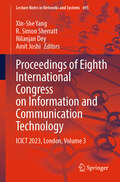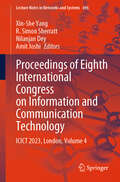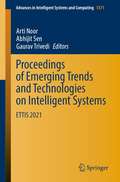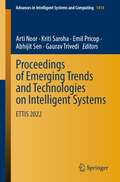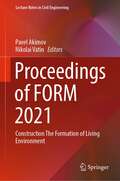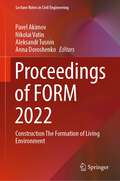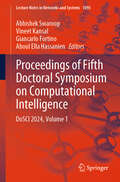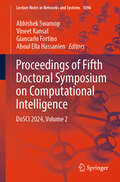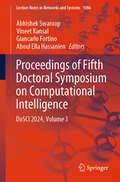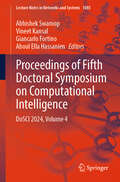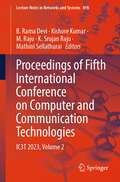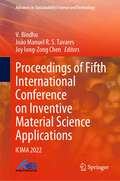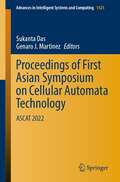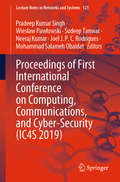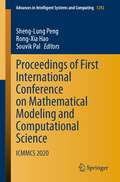- Table View
- List View
Proceedings of Eighth International Congress on Information and Communication Technology: ICICT 2023, London, Volume 1 (Lecture Notes in Networks and Systems #693)
by Xin-She Yang Nilanjan Dey Amit Joshi R. Simon SherrattThis book gathers selected high-quality research papers presented at the Eighth International Congress on Information and Communication Technology, held at Brunel University, London, on 20–23 February 2023. It discusses emerging topics pertaining to information and communication technology (ICT) for managerial applications, e-governance, e-agriculture, e-education and computing technologies, the Internet of Things (IoT) and e-mining. Written by respected experts and researchers working on ICT, the book offers a valuable asset for young researchers involved in advanced studies. The work is presented in four volumes.
Proceedings of Eighth International Congress on Information and Communication Technology: ICICT 2023, London, Volume 2 (Lecture Notes in Networks and Systems #694)
by Xin-She Yang Nilanjan Dey Amit Joshi R. Simon SherrattThis book gathers selected high-quality research papers presented at the Eighth International Congress on Information and Communication Technology, held at Brunel University, London, on 20–23 February 2023. It discusses emerging topics pertaining to information and communication technology (ICT) for managerial applications, e-governance, e-agriculture, e-education and computing technologies, the Internet of Things (IoT) and e-mining. Written by respected experts and researchers working on ICT, the book offers a valuable asset for young researchers involved in advanced studies. The work is presented in four volumes.
Proceedings of Eighth International Congress on Information and Communication Technology: ICICT 2023, London, Volume 3 (Lecture Notes in Networks and Systems #695)
by Xin-She Yang Nilanjan Dey Amit Joshi R. Simon SherrattThis book gathers selected high-quality research papers presented at the Eighth International Congress on Information and Communication Technology, held at Brunel University, London, on 20–23 February 2023. It discusses emerging topics pertaining to information and communication technology (ICT) for managerial applications, e-governance, e-agriculture, e-education and computing technologies, the Internet of Things (IoT) and e-mining. Written by respected experts and researchers working on ICT, the book offers a valuable asset for young researchers involved in advanced studies. The work is presented in four volumes.
Proceedings of Eighth International Congress on Information and Communication Technology: ICICT 2023, London, Volume 4 (Lecture Notes in Networks and Systems #696)
by Xin-She Yang Nilanjan Dey Amit Joshi R. Simon SherrattThis book gathers selected high-quality research papers presented at the Eighth International Congress on Information and Communication Technology, held at Brunel University, London, on 20–23 February 2023. It discusses emerging topics pertaining to information and communication technology (ICT) for managerial applications, e-governance, e-agriculture, e-education and computing technologies, the Internet of Things (IoT) and e-mining. Written by respected experts and researchers working on ICT, the book offers a valuable asset for young researchers involved in advanced studies. The work is presented in four volumes.
Proceedings of Emerging Trends and Technologies on Intelligent Systems: ETTIS 2021 (Advances in Intelligent Systems and Computing #1371)
by Arti Noor Abhijit Sen Gaurav TrivediThis book presents best selected papers presented at the International Conference on Emerging Trends and Technologies on Intelligent Systems (ETTIS 2021) held from 4 – 5 March 2021 in online mode at C-DAC, Noida, India. The book includes current research works in the areas of artificial intelligence, big data, cyber-physical systems, and security in industrial/real-world settings. The book illustrates on-going research results, projects, surveying works, and industrial experiences that describe significant advances in all of the related areas.
Proceedings of Emerging Trends and Technologies on Intelligent Systems: ETTIS 2022 (Advances in Intelligent Systems and Computing #1414)
by Emil Pricop Arti Noor Abhijit Sen Gaurav Trivedi Kriti SarohaThis book presents best selected papers presented at the 2nd International Conference on Emerging Trends and Technologies on Intelligent Systems (ETTIS 2022) to be held from 22 – 23 March 2022 in online mode at C-DAC, Noida, India. The book includes current research works in the areas of artificial intelligence, big data, cyber-physical systems, and security in industrial/real-world settings. The book illustrates on-going research results, projects, surveying works, and industrial experiences that describe significant advances in all of the related areas.
Proceedings of FORM 2021: Construction The Formation of Living Environment (Lecture Notes in Civil Engineering #170)
by Pavel Akimov Nikolai VatinThis book gathers the latest advances, innovations, and applications in the field of environmental and construction engineering, as presented by international researchers at the XXIV International Scientific Conference "Construction: The Formation of Living Environment", held in Moscow, Russia on April 22-24, 2021. It covers highly diverse topics, including sustainable innovative development of the construction industry, building materials, reliability of buildings and constructions and safety in construction, modelling and mechanics of building structures, engineering and smart systems in construction, climate change and urban environment. The contributions, which were selected by means of a rigorous international peer-review process, highlight numerous exciting ideas that will spur novel research directions and foster multidisciplinary collaborations.
Proceedings of FORM 2022: Construction The Formation of Living Environment (Lecture Notes in Civil Engineering #282)
by Pavel Akimov Nikolai Vatin Aleksandr Tusnin Anna DoroshenkoThis book gathers the latest advances, innovations, and applications in the field of environmental and construction engineering, as presented by international researchers at the XXV International Scientific Conference "Construction: The Formation of Living Environment", held in Moscow, Russia on April 20-22, 2022. It covers highly diverse topics, including sustainable innovative development of the construction industry, building materials, reliability of buildings and constructions and safety in construction, modelling and mechanics of building structures, engineering and smart systems in construction, climate change and urban environment. The contributions, which were selected by means of a rigorous international peer-review process, highlight numerous exciting ideas that will spur novel research directions and foster multidisciplinary collaborations.
Proceedings of Fatigue, Durability and Fracture Mechanics
by S. Seetharamu K. Bhanu Sankara Rao Raghunath Wasudev KhareThis book presents the proceedings of Fatigue Durability India 2016, which was held on September 28-30 at J N Tata Auditorium, Indian Institute of Science, Bangalore. This 2nd International Conference & Exhibition brought international industrial experts and academics together on a single platform to facilitate the exchange of ideas and advances in the field of fatigue, durability and fracture mechanics and its applications. This book comprises articles on a broad spectrum of topics from design, engineering, testing and computational evaluation of components and systems for fatigue, durability, and fracture mechanics. The topics covered include interdisciplinary discussions on working aspects related to materials testing, evaluation of damage, nondestructive testing (NDT), failure analysis, finite element modeling (FEM) analysis, fatigue and fracture, processing, performance, and reliability. The contents of this book will appeal not only to academic researchers, but also to design engineers, failure analysts, maintenance engineers, certification personnel, and R&D professionals involved in a wide variety of industries.
Proceedings of Fifth Doctoral Symposium on Computational Intelligence: DoSCI 2024, Volume 1 (Lecture Notes in Networks and Systems #1095)
by Giancarlo Fortino Aboul Ella Hassanien Abhishek Swaroop Vineet KansalThis book features high-quality research papers presented at Fifth Doctoral Symposium on Computational Intelligence (DoSCI 2024), jointly organised by Institute of Engineering & Technology, Lucknow, India, and School of Open Learning, University of Delhi in association with University of Calabria, Italy, on May 10, 2024. This book discusses the topics such as computational intelligence, artificial intelligence, deep learning, evolutionary algorithms, swarm intelligence, fuzzy sets and vague sets, rough set theoretic approaches, quantum-inspired computational intelligence, hybrid computational intelligence, machine learning, computer vision, soft computing, distributed computing, parallel and grid computing, cloud computing, high-performance computing, biomedical computing, and decision support and decision making.
Proceedings of Fifth Doctoral Symposium on Computational Intelligence: DoSCI 2024, Volume 2 (Lecture Notes in Networks and Systems #1096)
by Giancarlo Fortino Aboul Ella Hassanien Abhishek Swaroop Vineet KansalThis book features high-quality research papers presented at Fifth Doctoral Symposium on Computational Intelligence (DoSCI 2024), jointly organized by Institute of Engineering & Technology, Lucknow, India, and School of Open Learning, University of Delhi in association with University of Calabria, Italy, on May 10, 2024. This book discusses the topics such as computational intelligence, artificial intelligence, deep learning, evolutionary algorithms, swarm intelligence, fuzzy sets and vague sets, rough set theoretic approaches, quantum-inspired computational intelligence, hybrid computational intelligence, machine learning, computer vision, soft computing, distributed computing, parallel and grid computing, cloud computing, high-performance computing, biomedical computing, and decision support and decision making.
Proceedings of Fifth Doctoral Symposium on Computational Intelligence: DoSCI 2024, Volume 3 (Lecture Notes in Networks and Systems #1086)
by Giancarlo Fortino Aboul Ella Hassanien Abhishek Swaroop Vineet KansalThis book features high-quality research papers presented at Fifth Doctoral Symposium on Computational Intelligence (DoSCI 2024), jointly organized by Institute of Engineering & Technology, Lucknow, India, and School of Open Learning, University of Delhi in association with University of Calabria, Italy, on May 10, 2024. This book discusses the topics such as computational intelligence, artificial intelligence, deep learning, evolutionary algorithms, swarm intelligence, fuzzy sets and vague sets, rough set theoretic approaches, quantum-inspired computational intelligence, hybrid computational intelligence, machine learning, computer vision, soft computing, distributed computing, parallel and grid computing, cloud computing, high-performance computing, biomedical computing, and decision support and decision making.
Proceedings of Fifth Doctoral Symposium on Computational Intelligence: DoSCI 2024, Volume 4 (Lecture Notes in Networks and Systems #1085)
by Giancarlo Fortino Aboul Ella Hassanien Abhishek Swaroop Vineet KansalThis book features high-quality research papers presented at Fifth Doctoral Symposium on Computational Intelligence (DoSCI 2024), jointly organized by Institute of Engineering & Technology, Lucknow, India, and School of Open Learning, University of Delhi, in association with University of Calabria, Italy, on May 10, 2024. This book discusses the topics such as computational intelligence, artificial intelligence, deep learning, evolutionary algorithms, swarm intelligence, fuzzy sets and vague sets, rough set theoretic approaches, quantum-inspired computational intelligence, hybrid computational intelligence, machine learning, computer vision, soft computing, distributed computing, parallel and grid computing, cloud computing, high-performance computing, biomedical computing, and decision support and decision-making.
Proceedings of Fifth International Conference on Computer and Communication Technologies: IC3T 2023, Volume 1 (Lecture Notes in Networks and Systems #897)
by K. Srujan Raju Mathini Sellathurai Kishore Kumar B. Rama Devi M. RajuThis book is a compilation of high-quality scientific papers presented at the 5th International Conference on Computer & Communication Technologies (IC3T 2023). The book covers cutting-edge technologies and applications of soft computing, artificial intelligence and communication. In addition, a variety of further topics are discussed, which include data mining, machine intelligence, fuzzy computing, sensor networks, signal and image processing, human–computer interaction, and web intelligence.
Proceedings of Fifth International Conference on Computer and Communication Technologies: IC3T 2023, Volume 2 (Lecture Notes in Networks and Systems #898)
by K. Srujan Raju Mathini Sellathurai Kishore Kumar B. Rama Devi M. RajuThis book is a compilation of high-quality scientific papers presented at the 5th International Conference on Computer & Communication Technologies (IC3T 2023). The book covers cutting-edge technologies and applications of soft computing, artificial intelligence and communication. In addition, a variety of further topics are discussed, which include data mining, machine intelligence, fuzzy computing, sensor networks, signal and image processing, human–computer interaction, and web intelligence.
Proceedings of Fifth International Conference on Computing, Communications, and Cyber-Security: IC4S'05 Volume 2 (Lecture Notes in Networks and Systems #1128)
by Pradeep Kumar Singh Gregory Epiphaniou Sudeep Tanwar Paulo J. Sequeira GonçalvesThis book features selected research papers presented at the Fifth International Conference on Computing, Communications, and Cyber-Security (IC4S'05) Volume 2, organized in India, during 8th–9th April, 2024. The conference was hosted at GEHU, Bhimtal Campus in India . It includes innovative work from researchers, leading innovators, and professionals in the areas of communication and network technologies, advanced computing technologies, data analytics and intelligent learning, the latest electrical and electronics trends, and security and privacy issues. The work is presented in two volumes.
Proceedings of Fifth International Conference on Computing, Communications, and Cyber-Security: IC4S’05 Volume 1 (Lecture Notes in Networks and Systems #991)
by Pradeep Kumar Singh Gregory Epiphaniou Sudeep Tanwar Maria GanzhaThis book features selected research papers presented at the Fifth International Conference on Computing, Communications, and Cyber-Security (IC4S 2023), organized in Ghaziabad India, during December 1–2, 2023. The conference was hosted at KEC Ghaziabad and Lisbon, Portugal. It includes innovative work from researchers, leading innovators, and professionals in the areas of communication and network technologies, advanced computing technologies, data analytics and intelligent learning, the latest electrical and electronics trends, and security and privacy issues. The work is presented in two volumes.
Proceedings of Fifth International Conference on Inventive Material Science Applications: ICIMA 2022 (Advances in Sustainability Science and Technology)
by João Manuel R. S. Tavares Joy Iong-Zong Chen V. BindhuThe book is a collection of best selected research papers presented at the 5th International Conference on Inventive Material Science Applications (ICIMA 2022) organized by PPG Institute of Technology, Coimbatore, India, during May 6–7, 2022. The book includes original research by material science researchers toward developing a compact and efficient functional elements and structures for micro-, nano-, and optoelectronic applications. The book covers important topics like nanomaterials and devices, optoelectronics, sustainable electronic materials, nanocomposites and nanostructures, hybrid electronic materials, medical electronics, computational material science, wearable electronic devices and models, and optical/nanosensors.
Proceedings of Fifth International Congress on Information and Communication Technology: ICICT 2020, London, Volume 1 (Advances in Intelligent Systems and Computing #1183)
by Xin-She Yang Nilanjan Dey Amit Joshi R Simon SherrattThis book gathers selected high-quality research papers presented at the Fifth International Congress on Information and Communication Technology, held at Brunel University, London, on February 20–21, 2020. It discusses emerging topics pertaining to information and communication technology (ICT) for managerial applications, e-governance, e-agriculture, e-education and computing technologies, the Internet of Things (IoT) and e-mining. Written by respected experts and researchers working on ICT, the book offers a valuable asset for young researchers involved in advanced studies.
Proceedings of Fifth International Congress on Information and Communication Technology: ICICT 2020, London, Volume 2 (Advances in Intelligent Systems and Computing #1184)
by Xin-She Yang Nilanjan Dey Amit Joshi Simon SherrattThis book gathers selected high-quality research papers presented at the Fifth International Congress on Information and Communication Technology, held at Brunel University, London, on February 20–21, 2020. It discusses emerging topics pertaining to information and communication technology (ICT) for managerial applications, e-governance, e-agriculture, e-education and computing technologies, the Internet of Things (IoT) and e-mining. Written by respected experts and researchers working on ICT, the book offers a valuable asset for young researchers involved in advanced studies.
Proceedings of First Asian Symposium on Cellular Automata Technology: ASCAT 2022 (Advances in Intelligent Systems and Computing #1425)
by Sukanta Das Genaro J. MartinezThis book gathers selected research papers presented at the First Asian Symposium on Cellular Automata Technology (ASCAT 2022), organized online by academicians from Kolkata, India, during March 3–5, 2022. The book presents one of the most emergent areas in natural computing, cellular automaton (CA). CA is a paradigm of uniform fine-grained parallel computation which has been explored to understand complex systems by developing its model at the microscopic level. The book discusses many real-life problems in the domain of very large-scale integration (VLSI) design and test, pattern recognition and classification, cryptography, pseudo-random pattern generation, image processing, sensor networks, material science, etc., by using CA.
Proceedings of First International Conference on Computational Electronics for Wireless Communications: ICCWC 2021 (Lecture Notes in Networks and Systems #329)
by Pramod Kumar Arvind Kumar Jaume Anguera Sanyog RawatThis book includes high-quality papers presented at Proceedings of First International Conference on Computational Electronics for Wireless Communications (ICCWC 2021), held at National Institute of Technology, Kurukshetra, Haryana, India, during June 11–12, 2021. The book presents original research work of academics and industry professionals to exchange their knowledge of the state-of-the-art research and development in computational electronics with an emphasis on wireless communications. The topics covered in the book are radio frequency and microwave, signal processing, microelectronics and wireless networks.
Proceedings of First International Conference on Computing, Communications, and Cyber-Security (Lecture Notes in Networks and Systems #121)
by Neeraj Kumar Pradeep Kumar Singh Sudeep Tanwar Wiesław Pawłowski Joel J. P. C. Rodrigues Mohammad Salameh ObaidatThis book features selected research papers presented at the First International Conference on Computing, Communications, and Cyber-Security (IC4S 2019), organized by Northwest Group of Institutions, Punjab, India, Southern Federal University, Russia, and IAC Educational Trust, India along with KEC, Ghaziabad and ITS, College Ghaziabad as an academic partner and held on 12–13 October 2019. It includes innovative work from researchers, leading innovators and professionals in the area of communication and network technologies, advanced computing technologies, data analytics and intelligent learning, the latest electrical and electronics trends, and security and privacy issues.
Proceedings of First International Conference on Mathematical Modeling and Computational Science: ICMMCS 2020 (Advances in Intelligent Systems and Computing #1292)
by Sheng-Lung Peng Souvik Pal Rong-Xia HaoThis book presents the most recent scientific and technological advances in the fields of engineering mathematics and computational science, to strengthen the links in the scientific community. It is a collection of high-quality, peer-reviewed research papers presented at the First International Conference on Mathematical Modeling and Computational Science (ICMMCS 2020), held in Pattaya, Thailand, during 14–15 August 2020. The topics covered in the book are mathematical logic and foundations, numerical analysis, neural networks, fuzzy set theory, coding theory, higher algebra, number theory, graph theory and combinatory, computation in complex networks, calculus, differential educations and integration, application of soft computing, knowledge engineering, machine learning, artificial intelligence, big data and data analytics, high-performance computing, network and device security, and Internet of things (IoT).
Proceedings of Fluid Mechanics and Fluid Power: Fluid Dynamics (Lecture Notes in Mechanical Engineering)
by G. Rajesh Hardik Kothadia K. R. Arun Jaywant H. ArakeriThis book presents select proceedings of the 10th International and 50th National Conference on Fluid Mechanics and Fluid Power. It covers recent research developments in the area of fluid mechanics, measurement techniques in fluid flows, and computational fluid dynamics. The key research topics discussed in this book are fundamental studies in flow instability and transition, fluid-structure interaction, multiphase flows, solidification, melting, cavitation, porous media flows, bubble and droplet dynamics, bio-mems, micro-scale experimental techniques, flow control devices, underwater vehicles, bluff body, bio-fluid mechanics, aerodynamics, turbomachinery, propulsion and power, heat transfer and thermal engineering, fluids engineering, advances in aerospace and defence technology, micro- and nano-systems engineering, acoustics, structures and fluids, advanced theory and simulations, novel experimental techniques in thermo-fluids engineering and many more. The book is a valuable reference for researchers and professionals interested in thermo-fluids engineering.


